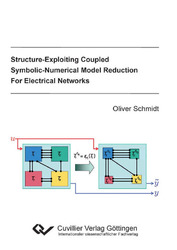| Departments | |
|---|---|
| Book Series (96) |
1378
|
| Nachhaltigkeit |
3
|
| Gesundheitswesen |
1
|
| Humanities |
2364
|
| Natural Sciences |
5406
|
| Mathematics | 229 |
| Informatics | 319 |
| Physics | 980 |
| Chemistry | 1363 |
| Geosciences | 131 |
| Human medicine | 243 |
| Stomatology | 10 |
| Veterinary medicine | 108 |
| Pharmacy | 147 |
| Biology | 835 |
| Biochemistry, molecular biology, gene technology | 121 |
| Biophysics | 25 |
| Domestic and nutritional science | 45 |
| Agricultural science | 1004 |
| Forest science | 201 |
| Horticultural science | 20 |
| Environmental research, ecology and landscape conservation | 148 |
| Engineering |
1793
|
| Common |
98
|
|
Leitlinien Unfallchirurgie
5. Auflage bestellen |
|
Advanced Search
Structure-Exploiting Coupled Symbolic-Numerical Model Reduction For Electrical Networks (English shop)
Oliver Schmidt (Author)Preview
Table of Contents, Datei (85 KB)
Extract, Datei (320 KB)
In order to avoid immense time and financial effort for the production of deficiently designed prototypes of integrated circuits (ICs), industrial circuit design uses mathematical models and simulations to predict and analyse the physical behavior of analog electronical systems. The thereby generated (partial) differential-algebraic systems of equations are composed of component characteristics and Kirchhoff laws.
During the last years, increasing miniaturization and integration density of components on a single chip led to systems containing several millions of equations, which have to be reduced to their dominant parts in order to handle the complexity. Besides a large number of numerical analysis and reduction methods, there also exist symbolic techniques, which indeed are costly to compute, but allow deeper analytical insights into the behavior of the system.
In this book, new strategies for the analysis and reduction of systems of ever-growing size and complexity are developed by exploiting the hierarchical structure of analog electronical circuits for coupled symbolic-numerical model reduction. Thereby, the entire circuit is considered as a system of subcircuits that are interconnected by a certain topology. By using a novel concept of subsystem sensitivities, a newly developed algorithm reduces the subcircuits separately from each other. This does not only allow for a faster solving of smaller problems, it further permits the coupling of different reduction techniques. Moreover, particularly in the symbolic case, larger systems become manageable at all. Finally, the advantages and the practicability of the new techniques are demonstrated on amplifier circuit examples typically used in industrial applications.
| ISBN-13 (Printausgabe) | 3869555025 |
| ISBN-13 (Hard Copy) | 9783869555027 |
| ISBN-13 (eBook) | 9783736935020 |
| Language | English |
| Page Number | 196 |
| Edition | 1 Aufl. |
| Volume | 0 |
| Publication Place | Göttingen |
| Place of Dissertation | TU Kaiserslautern |
| Publication Date | 2010-09-29 |
| General Categorization | Dissertation |
| Departments |
Mathematics
|
| Keywords | model reduction, symbolic model reduction, hierarchical model reduction, coupled symbolic-numerical model reduction, structure preservation, structure-exploiting model reduction, structure-preserving model reduction, analog circuit, electrical circuit |








